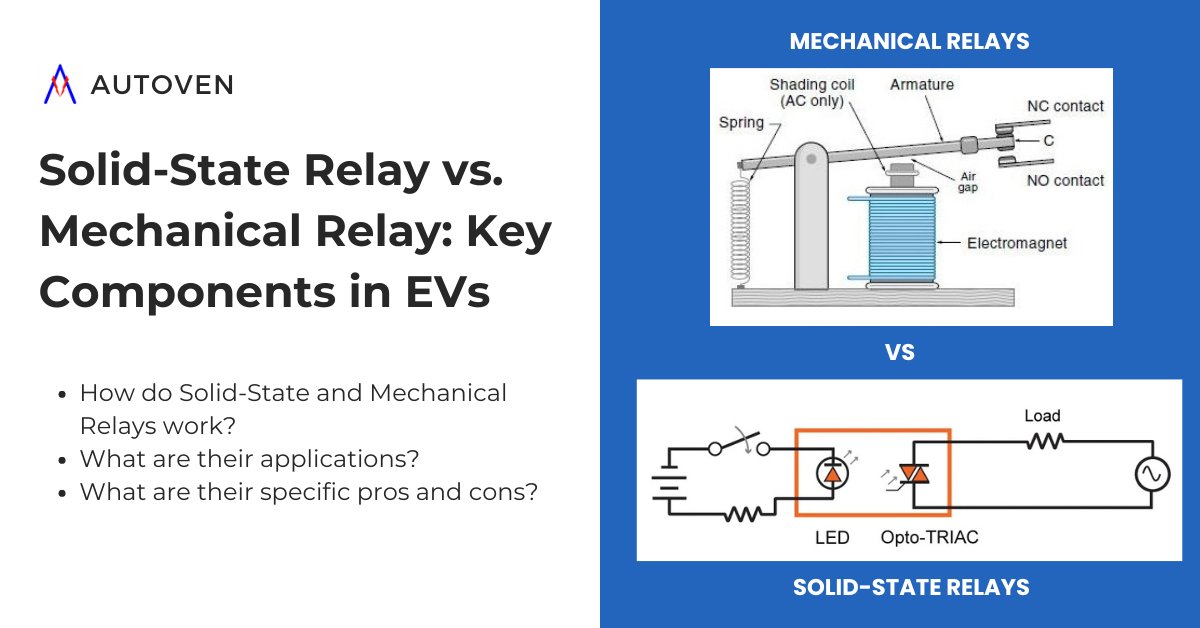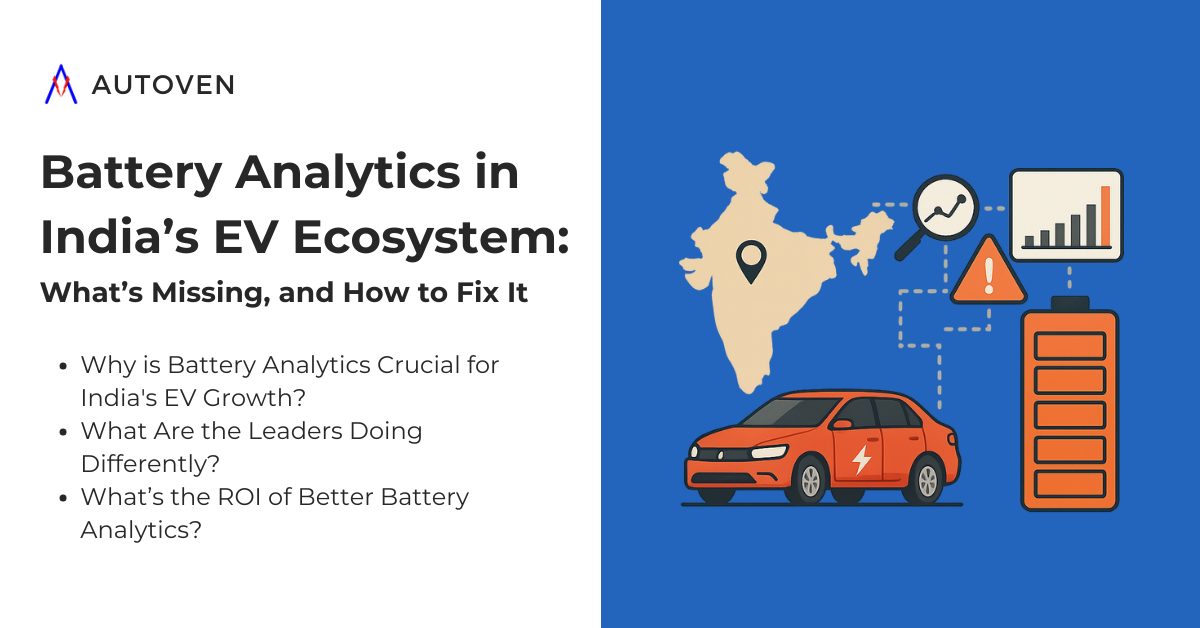Explore the differences between solid-state and mechanical relays in electric vehicles, their uses, and how they impact EV performance and efficiency.
Introduction
Electric vehicles (EVs) rely on advanced technology to ensure efficiency and safety. Among the critical components are relays—devices that control high-power circuits using low-power signals. In the EV industry, two types of relays are widely used: mechanical relays (also known as contactors) and solid-state relays (SSRs). Understanding their differences, advantages, and applications is essential for optimizing EV performance. Let us compare a solid state relay vs mechanical relay.
What Is a Mechanical Relay (Contactor)?
Mechanical relays, often called contactors, are robust electromechanical devices that switch high-power circuits on or off. They rely on physical movement to make or break a connection. Here are the key features of mechanical relays:
- Durability: Mechanical relays can endure up to 20,000 ON-OFF cycles depending on usage.
- Current Handling: These devices can handle large continuous currents and withstand current spikes for extended periods, making them ideal for high-power applications in EVs, such as powering motors and chargers.
- Temperature Tolerance: Mechanical relays are highly heat-tolerant and less sensitive to temperature fluctuations, whether gradual or rapid. This resilience means they don’t require heat sinks, reducing the need for additional thermal management.
- Power Consumption: Mechanical relays require 4W to 12W of power to operate their coils, which can contribute to battery discharge if not managed. To prevent unnecessary power loss when the vehicle is idle, the Battery Management System (BMS) needs to send an OFF command to disengage the contactor and conserve battery life.
While mechanical relays have proven reliable, their electromechanical nature limits their lifespan due to wear and tear from physical contact. This leads to fewer total ON-OFF cycles compared to SSRs.
What Is a Solid-State Relay?
A solid-state relay (SSR) is an electronic device that switches circuits on or off without moving parts. SSRs use power-electronic components such as MOSFETs, IGBTs, SCRs, and Triacs, making them ideal for controlling high-power systems compactly and efficiently.
Key characteristics of SSRs include:
- Cycle Longevity: In theory, SSRs offer an unlimited number of ON-OFF cycles because there are no physical contacts that degrade over time. However, electrical and thermal stress can still limit the lifespan of these components.
- Current Handling: SSRs can manage large continuous currents, but they are less effective at handling prolonged current spikes than mechanical relays. This is due to higher internal resistance in SSRs, which generates significant heat.
- Thermal Management: SSRs can heat up quickly under high currents, so they require proper thermal management. This typically involves a heat sink or even a cooling fan to dissipate heat and ensure reliable operation.
- Power Efficiency: One significant advantage of SSRs is their low power consumption. They require only 0.01W to 0.04W to switch on, ensuring battery longevity even when the vehicle remains idle for extended periods.
- Advanced Features: SSRs enable Pulse Width Modulation (PWM) switching. This allows them to reduce output voltage currents in overcurrent or short-circuit events. This feature is crucial for ensuring the safety and longevity of EV components.
Solid State Relay vs Mechanical Relay: A Comparison
Let’s break down the core differences between SSRs and mechanical relays in the context of EV applications:
| Feature | Mechanical Relay (Contactor) | Solid-State Relay (SSR) |
| Operating Mechanism | Electromechanical (Physical movement to make/break contact) | Electronic (No moving parts) |
| ON-OFF Cycles | Up to 20,000 cycles | Theoretically unlimited cycles |
| Current Handling | Large continuous currents and longer-duration spikes | Large currents, but spikes only for short durations |
| Heat Management | Heat-tolerant, no need for heat sinks | Requires heat sinks or cooling fans due to heat generation |
| Power Consumption | 4W to 12W (power-hungry, causes battery drain if idle) | 0.01W to 0.04W (very efficient) |
| Applications | Motors, chargers, high-power systems | Battery chargers, power supplies, converters |
| Thermal Stress Tolerance | High tolerance for temperature fluctuations | Susceptible to thermal stress if not managed |
| Additional Features | None | PWM switching for over-current protection |
Applications of Solid State Relay vs Mechanical Relay in EVs
Relays are essential components in the power management systems of electric vehicles (EVs), where they control the flow of electricity between the vehicle’s power sources and its various subsystems. Both mechanical relays (contactors) and solid-state relays (SSRs) serve critical functions, but their applications differ based on their unique properties and capabilities.
Mechanical Relays (Contactors)
Mechanical relays are typically used in high-power applications because they can handle large continuous currents and withstand long-duration current spikes. Some of the most common applications of mechanical relays in EVs include:
- Drivetrain Control: Mechanical relays are commonly used in the electric powertrain. They manage the large electrical currents required to power the vehicle’s motor. Their robust design allows them to control the high-power output needed to drive the vehicle.
- Battery Pack Management: EV battery packs store and deliver high energy. Mechanical relays are often responsible for connecting and disconnecting battery modules to the main power distribution system. Their ability to tolerate heat and handle continuous currents makes them well-suited for this function.
- High-Current Charging Systems: EVs require powerful charging systems to replenish their batteries efficiently. In fast-charging applications, mechanical relays manage the flow of electricity from external chargers to the battery. Their durability and capacity to handle surges and spikes are crucial for this application, ensuring safe and reliable charging.
- Auxiliary Power Distribution: In addition to the main drivetrain, EVs have various auxiliary systems such as heating, ventilation, and air conditioning (HVAC), lighting, and infotainment. These subsystems often use mechanical relays to manage power distribution, particularly when high-current load conditions appear intermittently.
Mechanical relays’ reliability in high-power and high-current systems makes them indispensable in these critical applications. However, their limited ON-OFF cycles and higher power consumption necessitate careful management, particularly in terms of battery efficiency.
Solid-State Relays (SSRs)
Solid-state relays (SSRs) are favored in applications with paramount efficiency, precision, and low power consumption. Unlike mechanical relays, SSRs have no moving parts. This feature makes them ideal for applications that require frequent switching and reduced wear and tear. Key applications of SSRs in EVs include:
- Battery Chargers: In EV charging systems, particularly onboard chargers, SSRs manage the conversion of AC power from the grid to DC power used by the vehicle’s battery. Their ability to handle frequent switching without mechanical degradation makes them perfect for ensuring smooth and reliable charging cycles, even in demanding environments.
- Regulated Power Supplies: SSRs regulate power supply systems that ensure the vehicle’s electronic systems receive stable and precise voltage levels. These include critical systems such as the vehicle’s control units (e.g., battery management systems, motor controllers, and sensors), which require constant and stable power to function optimally.
- AC and DC Converters: EVs rely on a combination of AC and DC power to operate various systems. SSRs are used in converters to switch between AC and DC circuits efficiently. Their high-speed switching capabilities and minimal power loss ensure that energy is transferred efficiently, reducing heat generation and improving overall vehicle performance.
- Inverter Drives: Electric motor inverters convert DC power from the battery to AC power used by the motor. They rely on SSRs for precise control of power flow. The SSRs’ PWM switching capability allows for modulation of the current, ensuring smooth acceleration, deceleration, and overall energy management of the motor, which enhances both performance and battery efficiency.
- Safety and Protection Systems: SSRs are often integrated into EVs’ safety circuits, where they manage power flow during overcurrent or short-circuit events. Their ability to quickly reduce output voltage and prevent damage to sensitive electronics is critical in maintaining the vehicle’s overall safety and reliability.
- Thermal Management Systems: SSRs require thermal management, so they are often part of the vehicle’s cooling systems. They ensure that high-temperature components like power electronics and batteries remain within safe operating limits. Their integration with cooling fans and heat sinks ensures that both the SSRs and other electronic systems perform reliably under varying conditions.
Both mechanical and solid-state relays are vital for the successful operation of electric vehicles, with their unique strengths determining where they are most effective. Mechanical relays shine in high-power, durable applications, while SSRs excel in precise, efficient, and frequently switched systems. By leveraging both types of relays in the appropriate scenarios, EVs can achieve optimal power management, safety, and efficiency.
Pros and Cons of Solid State Relay vs Mechanical Relay
Mechanical Relays (Contactors):
- Pros:
- Durable and robust in high-power applications.
- Heat-tolerant, requiring minimal thermal management.
- Handles long-duration current spikes.
- Cons:
- Limited ON-OFF cycles due to wear and tear.
- Higher power consumption can drain the battery when idle.
Solid-State Relays (SSRs):
- Pros:
- Theoretically, there are unlimited cycles due to the absence of moving parts.
- Extremely efficient in terms of power consumption.
- Capable of advanced features like PWM switching.
- Cons:
- Requires heat sinks or additional thermal management systems.
- Less effective at handling long-duration current spikes.
Conclusion
Both solid-state and mechanical relays have essential roles in the EV industry, each excelling in different areas. With their robustness and heat tolerance, mechanical relays are perfect for high-power, high-current applications. Solid-state relays, with their efficient power use and advanced control features, are ideal for more precise, lower-power applications. When choosing between the two, it’s important to consider the specific requirements of the EV system, particularly in terms of current handling, thermal management, and longevity.
Optimizing these relay systems can greatly enhance the overall performance, safety, and efficiency of electric vehicles, making them crucial components in the future of transportation.
Key takeaways-
- Mechanical and Solid-state relays are crucial components used in EVs in various subsystems for switching purposes.
- Mechanical relays have electromechanical switching capabilities and are used in high-voltage, high-current applications, whereas SSRs are electronic and are used in situations where energy efficiency and compactness are required.
- Mechanical relays are used in applications like powertrain control and high-current charging systems, while SSRs are used in inverter drives and thermal management systems. Based on their properties, each of the two has specific applications.


